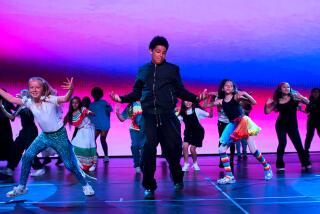Over the Top
- Share via
GRANADA HILLS — Patrick Henry Middle School students are, quite literally, learning the ropes.
Through an innovative physical education program, the sixth- through eighth-graders are building confidence, trust, teamwork and communication skills by maneuvering through a rope obstacle course.
The $25,000 course, called the Anne and Kirk Douglas Adventure Learning Center, was built through a grant from a $1 million fund set up by the actor and his wife to pay for landscaping and equipment at Los Angeles schools.
The course, which includes 20 different obstacles, features a cargo net climb, trapeze, balance beam and a zip line--a 275-foot-long rope suspended between two 65-foot-tall telephone poles. It was designed by Alan Wright, assistant professor of leisure studies and recreation at Cal State Northridge.
The course isn’t just a souped-up jungle gym, school officials say, but a useful way to teach life’s lessons.
“We are trying to teach them that the way to handle difficult situations in life is not to scream and yell and give up in frustration, but to ask questions and treat people properly,” said Chad Fenwick, the school’s physical education department chairman.
Because the rope course is part of regular physical education classes, he said, all students get the chance to swing Tarzan-style from “vine” ropes or drop four feet into the arms of their classmates.
*
Fenwick said the course is a great equalizer among students with varied social, academic and athletic abilities and that it forces them to work together to overcome obstacles.
“There was this tiny girl who was like a spider climbing up the ropes, and she was telling these wannabe gang kids, who were scared, how to do it,” Fenwick said.
Students also learn to work together through various scenarios, Fenwick said.
For example, he said, students use a plank and fulcrum to cross a pretend Amazon River and deliver medicine to the rest of the world. The problem is that the planks are too short to cover the distance between fulcrums.
“They have to learn a little bit about physics and balance,” Fenwick said, to ensure that everyone crosses safely.
Other tasks involve students walking with linked arms across a cable suspended a foot off the ground without losing someone or swinging 22 feet above ground while three classmates hold a safety line.
“We are trying to teach kids to take risks, but in a positive and controlled way,” Fenwick said. “We want them to think about what they are doing, and to do it safely.”


